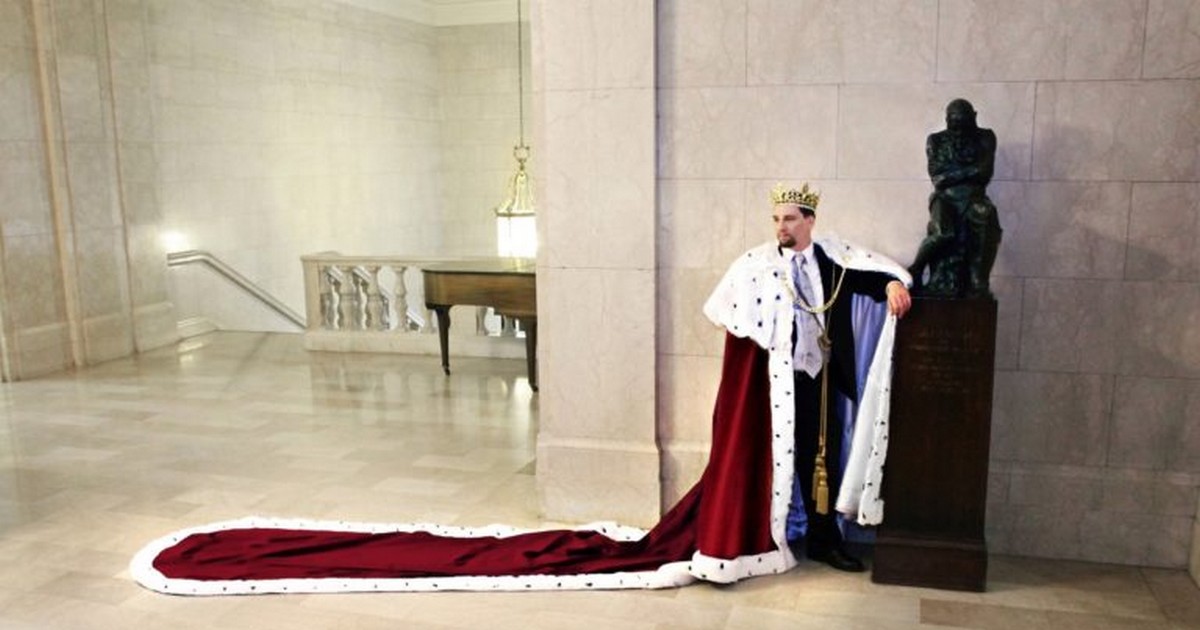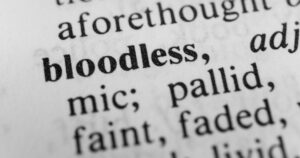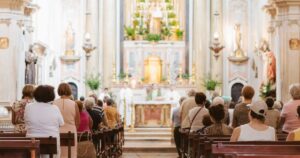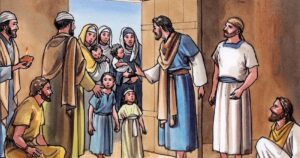Here is something that is not to be done: stepping on the train of a king’s robe.
With that in mind, recall what Isaiah saw. “I saw the Lord sitting on a throne, high and lifted up, and the train of His robe filled the temple.” (Isaiah 6:1). Since the train of the Lord’s robe filled the temple, and since we must not step on a king’s train, that leaves nowhere for us to stand in the temple.
He saw the Lord, and what more he saw was the all-filling robe of the indescribable One. As far as the eye of the seer could look at first, the ground was covered by his splendid robe. There was consequently no room for any one to stand. And the vision of the seraphim was in accordance with this.[1]
“Above it stood seraphim; each one had six wings: with two he covered his face, with two he covered his feet, and with two he flew.” (Isaiah 6:2) They needed their wings. Even the holy seraphim cannot stand on the King’s train.
So I said:
“Woe is me, for I am I undone!
Because I am a man of unclean lips,
And I dwell in the midst of a people of unclean lips;
For my eyes have seen the King,
The LORD of hosts.” (Isaiah 6:5)
As sinners, we have no standing before the Lord. With his train filling it, we cannot get through the door into his temple. How, then, can we worship? What makes worship possible? Somehow, we must get standing. We need standing before worship can proceed.
A form of worship that saunters casually into a sanctuary and commences with our service to God by attempting to praise him steps on the train of the Lord’s robe. It fails to begin where we were: in sin, outside the temple.
A better form of worship begins by invoking the presence of God according to what gives us standing to enter before him: Baptism, Confession, and Absolution. By these, we have the forgiveness of sins, which is the sole ground upon which we can stand. No wonder, then, that our Lutheran liturgy begins with the Invocation of the Name into which we were baptized, the Father, Son, and Holy Spirit, and proceeds to Confession and Absolution. Luther recovered Confession and Absolution from Penance (something we must do) and restored it to Baptism (something God does for us).
By the Law, worshipers went through the seven courts of the Temple in a gradual approach to God. By the Law, ordinary sinners never got there. Only the priests could enter some precincts. Only the High Priest could enter the innermost court, the Holy of Holies. He could enter it only once a year, on the Day of Atonement.
At the death of Christ, the veil of the temple between the Holy Place and the Most Holy Place was torn. Christ is the High Priest who, by his death, throws open the Holy of Holies.
In Baptism, we are baptized into his death, by which “we have access by faith into this grace in which we stand.” (Romans 5:2) This is the standing we need.
“As many of us as were baptized into Christ Jesus were baptized into His death. Therefore we were buried with Him through baptism into death, that just as Christ was raised from the dead by the glory of the Father, even so we also should walk in newness of life.” (Romans 6:3)
In Christ, “we have such a High Priest, who is seated at the right hand of the throne of the Majesty in the heavens.” (Hebrews 8:1) By his work as our High Priest, we may “come boldly to the throne of grace, that we may obtain mercy and find grace to help in time of need.” (Hebrews 4:16)
Spiritually, we were raised from the dead by Baptism. That is where our life began. “Baptism now saves you,” and gives you “the answer of a good conscience toward God, through the resurrection of Jesus Christ.” (1 Peter 3:21)
Upon the standing of forgiveness, resurrection, and a good conscience, worship becomes possible, and indeed, God earnestly invites you to come with all boldness before the throne of grace.
As marvelous as what has been said to this point might seem, the full extent of it is beyond human comprehension. Although Baptism makes us holy, recall that the holy seraphim do not stand on the Lord’s robe. And neither do we, even in the holiness of Baptism. Standing on the King’s train simply is not done by anyone in any condition. What, then, did our Baptism do for us?
But God, who is rich in mercy, because of His great love with which He loved us, even when we were dead in trespasses, made us alive together with Christ (by grace you have been saved), and raised us up together, and made us sit together in the heavenly places in Christ Jesus, that in the ages to come He might show the exceeding riches of His grace in His kindness toward us in Christ Jesus. (Ephesians 2:4-6)
The gift of Baptism gives us the standing of justification forensically, but in worship, it gives us seating liturgically. We can be in the presence of the King, we can worship him, because he has seated us together in the heavenly places in Christ Jesus. In this posture, we are not stepping on the King’s train because He gives his train to us.
Many will recoil at this. How could we receive his train? How could we deserve it? Wait, did you say deserve? That doesn’t enter into this. It is a gift. This is the “exceeding riches of His grace in His kindness toward us in Christ Jesus.” The recoil is a faint hint of how exceeding are the riches of his grace.
Once a gift like this, the gift of Baptism, has been given, we have an entrance into the temple. No wonder, then, that the historic liturgy next proceeds with the Introit (entrance). The historic liturgy of the church is not haphazard or synthetic. It embodies and portrays faithfully the scriptural truths of sin and salvation. This liturgy can be learned but never mastered. It can be believed yet remains overwhelming. It crushes with contrition and consoles with gracious assurance by the propitiatory blood of Christ, which the liturgy will give into your mouth in the Service of the Sacrament. This blood was shed for the remission of all your sins, and when Christ gives you his blood to drink, He gives with it what He shed it for, the forgiveness of all your sins.
Recall what we heard earlier from Hebrews 4:16, when we “come boldly to the throne of grace,” we do it “ that we may obtain mercy and find grace to help in time of need.” No wonder, then, that the next thing after the Introit is the Kyrie, “Lord have mercy upon us, Christ have mercy upon us, Lord have mercy upon us.” The liturgy simply enacts what Scripture says. And since the Kyrie is both a prayer and a confession of faith, as if we were also singing, “The Lord has mercy, Christ has mercy, the Lord has mercy,” no wonder, then, that the liturgy next breaks forth in the Gloria in Excelsis. Believing and confessing his mercy first applied to each one of us in our Baptisms, we can praise and worship him in his temple.
________________________
[1] C. F. Keil and F. Delitzsch, Commentary on the Old Testament, 7:124 (Edinburgh: T & T Clark, 1866-91; Hendrickson Publishers reprint, second printing 2001).




